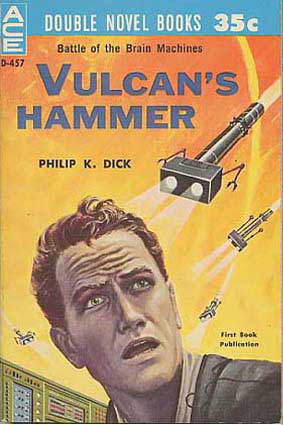Science Fiction
Dictionary
A B C D E F G H I J K L M N O P Q R S T U V W X Y Z
Google's Project Wing Will Find You

Google has been testing Project Wing, its drone delivery system, in Warwick, Australia.
(Google Project)
A white vehicle appears above the trees, a tiny plane a bit bigger than a seagull. It glides towards Parfitt, pitches upwards to a vertical position, and hovers near him, a couple hundred feet in the air. From its belly, a package comes tumbling downward, connected by a thin line to the vehicle itself. Right before the delivery hits the ground, it slows, hitting the earth with a tap. The delivery slows, almost imperceptibly, just before it hits the ground, hardly kicking up any dust. A small rectangular module on the end of the line detaches the payload, and ascends back up the vehicle, locking into place beneath the nose. As the wing returns to flying posture and zips back to its launch point half a mile away, Parfitt walks over to the package, opens it up, and extracts some treats for his dogs.The Australian test flight and 30 others like it conducted in mid-August are the culmination of the first phase of Project Wing, a secret drone program that’s been running for two years at Google X, the company’s whoa-inducing, long-range research lab.
During this initial phase of development, Google landed on an unusual design called a tail sitter, a hybrid of a plane and a helicopter that takes off vertically, then rotates to a horizontal position for flying around. For delivery, it hovers and winches packages down to the ground. At the end of the tether, there’s a little bundle of electronics they call the “egg,” which detects that the package has hit the ground, detaches from the delivery, and is pulled back up into the body of the vehicle.
Fans of Philip K. Dick are probably thinking that the surveillance drones from his 1960 novel Vulcan's Hammer are uncomfortably close to being made a reality.

(robot tracking devices from Vulcan's Hammer)
Madness, he thought. The ultimate horror for our paranoid culture; vicious unseen mechanical entities that flit at the edges of our vision, that can go anywhere, that are in our very midst. And there may be an unlimited number of them.
Via The Atlantic.
Scroll down for more stories in the same category. (Story submitted 9/1/2014)
Follow this kind of news @Technovelgy.| Email | RSS | Blog It | Stumble | del.icio.us | Digg | Reddit |
Would
you like to contribute a story tip?
It's easy:
Get the URL of the story, and the related sf author, and add
it here.
Comment/Join discussion ( 1 )
Related News Stories - (" Surveillance ")
LingYuan Vehicle Roof Drones Now Available, ala Blade Runner 2049
Accompanied by a small selection of similar ideas from science fiction.
Chameleon Personalized Privacy Protection Mask
'...the Virtual Epiphantic Identity Lustre.' - Neal Stephenson, 2019.
Spherical Police Robot Rolls In China
'Rand could effectively be in several places at once...' - Niven and Pournelle, 1981.
Vietnam To Have Full Biometric Transparency
'inscriptions too small to be seen with the naked eye; microscopic data...' - Eric Frank Russell, 1939.
Technovelgy (that's tech-novel-gee!) is devoted to the creative science inventions and ideas of sf authors. Look for the Invention Category that interests you, the Glossary, the Invention Timeline, or see what's New.
Science Fiction
Timeline
1600-1899
1900-1939
1940's 1950's
1960's 1970's
1980's 1990's
2000's 2010's
Current News
Natural Gait With Prosthetic Connected To Nervous System
'The leg was to function, in a way, as a servo-mechanism operated by Larry’s brain...'
Woman Marries Computer, Vonnegut's Dream Comes True
'Men are made of protoplasm... Lasts forever.'
Spidery 'Walk Me' Toyota Autonomous Wheel Chair Like Star Wars
Walk along with the emperor.
Dancing Robots Taught Dance Moves
'A clockwork figure would be the thing for you...'
Proof Of Robothood - Not A Person
'Who are you people? - Show 'em.'
Indonesian Clans Battle
'The observation vehicle was of that peculiar variety used in conveying a large number of people across rough terrain.'
The 'Last Mile' In China Crowded With Delivery Robots
Yes, it's a delivery robot. On wheels.
Tornyol Microdrone Kills Mosquitoes
'The real border was defended by... a swarm of quasi-independent aerostats.'
PLATO Spacecraft, Hunter Of Habitable Planets, Now Ready
'I ... set my automatic astronomical instruments to searching for a habitable planet.'
Factory Humanoid Robots Built By Humanoid Robots
'...haven't you a section of the factory where only robot labor is employed?'
iPhone Air Fulfils Jobs' Promise From 2007 - A Giant Screen!
'... oblongs were all over the floor and surfaces.'
ChatGPT Now Participates in Group Chats
'...the city was their laboratory in human psychology.'
iPhone Pocket All Sold Out!
'A long, strong, slender net...'
Did The Yautja Have These First?
What a marvel of ingenuity the little device was!
Jetson ONE Air Races Begin, Can Air Polo Be Far Behind?
'If you're one of those rarities who haven't attended a rocket-polo "carnage", let me tell you it's a colorful affair.'
Will Space Stations Have Large Interior Spaces Again?
'They filed clumsily into the battleroom, like children in a swimming pool for the first time, clinging to the handholds along the side.'
